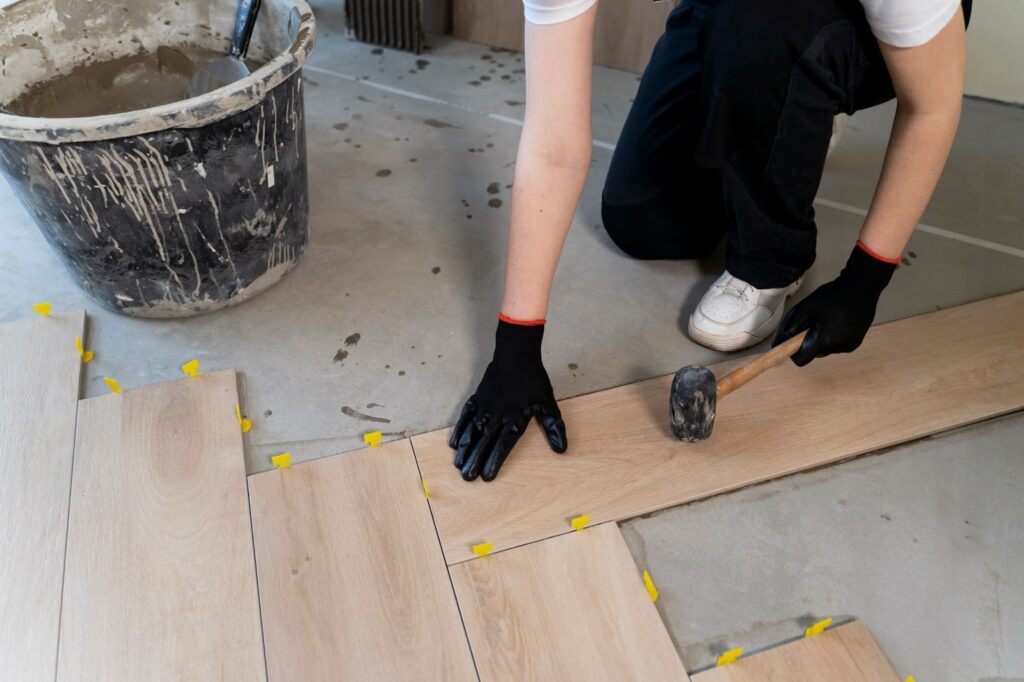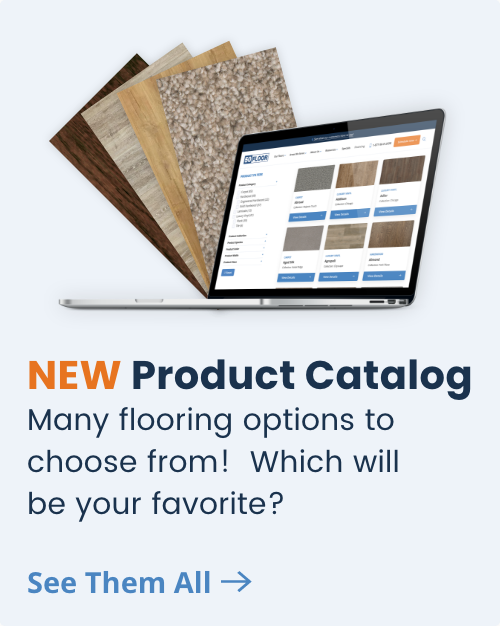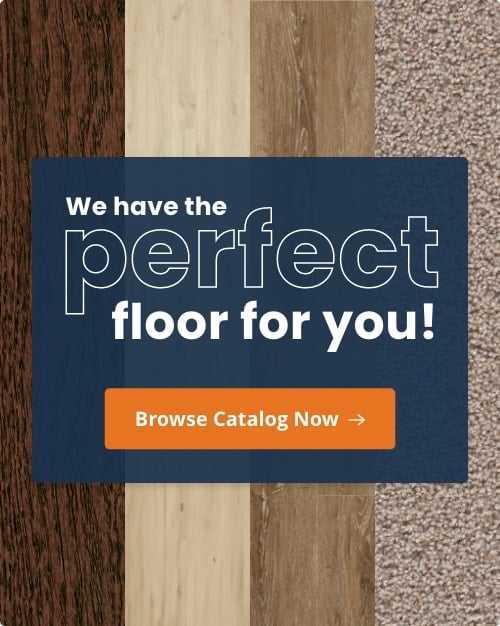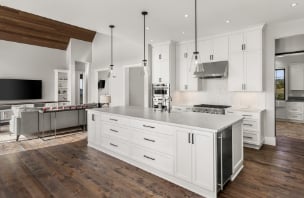

If you’ve ever walked into a home and instantly thought “this feels right,” you’ve experienced the silent power of flooring. Before buyers even notice the kitchen backsplash or the size of the closet, their eyes—and feet—have already made a judgment call. In real estate, those first five seconds can make or break a sale.
According to a National Association of Realtors (NAR) report, updated flooring can boost a home’s perceived value by up to 10%. Simply put: flooring isn’t just underfoot, it’s underpriced as one of the easiest ways to add instant appeal.
The Top Flooring Materials That Boost Property Value (Ranked by ROI)
Not all floors are created equal—and when it comes to resale value, some materials can quite literally pay for themselves. New flooring projects can deliver an average return on investment (ROI) between 70% and 80%, depending on the material and location. In other words, the right floors don’t just look good—they make financial sense.
Here’s how today’s top contenders stack up:
#1. Hardwood
If real estate had a “sure thing,” it would be hardwood floors. They’re the ultimate classic, being warm, durable, and endlessly refinishable.
Buyers associate hardwood with quality and longevity, which is why homes with genuine hardwood floors often sell up to 10% faster and for 2–3% more, according to Zillow. Whether you go for rich walnut or light oak, hardwood instantly elevates the entire space.
#2. Luxury Vinyl Plank (LVP)
Once considered a budget alternative, LVP has exploded in popularity, and for good reason. It mimics the look of real wood or stone at a fraction of the cost, stands up to pets and spills, and looks fantastic in listing photos. It’s the perfect blend of style and practicality that today’s busy buyers crave.
If hardwood feels too pricey, a quality LVP install can still deliver ROI while appealing to design-conscious shoppers who love that sleek, “move-in ready” vibe.
#3. Tile & Stone
Tile and stone floors bring instant polish, especially in high-traffic or high-moisture areas. Think marble-look porcelain in a master bath or textured slate in a front entryway. These materials signal “upscale and easy to clean,” two phrases that make buyers’ hearts race.
Porcelain tile tends to yield a considerable ROI, but it’s the visual impact that often seals the deal. Pair light tile with dark grout for a modern contrast that pops in photos.
#4. Carpet
Carpet still has a place, but choose wisely. In bedrooms, a soft, neutral carpet can add warmth and comfort that buyers appreciate.
But in main living areas? It’s usually a turn-off. Old or stained carpet screams “hidden costs.” If you can only upgrade one thing before listing, replacing worn carpet with vinyl or laminate in common areas gives you the best bang for your buck.
Color Psychology and Buyer Perception
Color doesn’t just influence décor; it shapes how buyers feel the moment they walk through the door. Flooring color, in particular, plays a huge role in creating emotional appeal, setting the tone for the entire home, and even affecting how large or luxurious a space appears in photos.
Neutrals That Sell
In terms of resale value, subtle colors are always preferred over bold ones. Real estate pros swear by versatile tones like light oak, greige, and soft walnut, hues that feel warm, natural, and timeless. These shades let buyers imagine their furniture, their décor, and their lives in the space.
Neutral floors also reflect more light, creating an airy, open feeling that instantly makes rooms more inviting. Think Scandinavian calm meets modern comfort, a combination that sells fast.
Regional Color Trends: Know Your Market
Flooring color preferences can vary dramatically by region. In coastal areas, buyers tend to favor pale, sun-washed woods and gray-toned planks that echo sand and driftwood.
In urban or luxury markets, however, deep espresso and rich walnut finishes reign supreme, lending a sense of drama and sophistication.
If you’re staging or selling, look at local listings to see which flooring tones are trending in your area. Matching those market expectations can give your property an instant competitive edge.
Consistency is Key: One Color, Bigger Feel
Ever notice how model homes flow seamlessly from room to room? That’s no accident. Using a consistent flooring color throughout the main living spaces creates visual continuity—which, to the buyer’s eye, makes the home feel larger, cleaner, and more cohesive.
Multiple flooring transitions can chop up a home’s layout and make it feel smaller or dated. Even if you’re working with different materials (like tile in the kitchen and vinyl in the living area), keeping the tones within the same color family helps maintain that sense of spaciousness.
The Photography Factor: Floors That Shine on Camera
In today’s market, your home’s first showing happens online, and the floor plays a starring role in every photo. The right finish can make a space look warm, expansive, and move-in ready, while the wrong one can flatten light and highlight flaws. Think of your flooring as your home’s red carpet: it needs to perform beautifully on camera.
How Sheen, Plank Width, and Pattern Affect Photos
Real estate photographers will tell you that texture and proportion are everything.
- Wider planks make rooms look larger and more luxurious in photos by reducing visual “busyness.”
- Subtle patterns like herringbone or chevron add just enough character to catch the eye without overwhelming the frame.
- Too much shine or reflective grain can bounce light unevenly, distracting from the overall composition.
If you’re flooring for resale, think simple, neutral, and photo-friendly; your camera roll (and buyers) will thank you.
Matte vs. Glossy Finishes: The Magazine-Ready Look
While glossy floors can feel glamorous in person, they’re notoriously tricky to photograph. Reflections, glare, and visible footprints can all ruin a perfect shot.
Matte or low-sheen finishes are the true secret to “editorial” interiors. They diffuse light evenly, hide imperfections, and create that soft, high-end glow you see in design magazines. For most listings, a satin or matte finish strikes the perfect balance between polish and authenticity.
Flooring Layout & Design Considerations
When it comes to flooring that truly impresses buyers, it’s not just about the material; the way your floors are laid out can make or break a home’s overall appeal. Paying attention to plank size, pattern, transitions, and subfloor quality can subtly elevate the perception of your space and even make rooms feel larger, more luxurious, and move-in ready.
A. Plank Size & Pattern
The size and pattern of your flooring planks play a big role in the style and feel of a room.
- Wide vs. Narrow Planks: Wide planks give a modern, upscale look and can make a space feel more expansive. They’re especially effective in living rooms and open-concept areas. Narrow planks, on the other hand, lend a classic or traditional vibe, think cozy cottages or older homes where charm is key. Choosing the right width depends on both the room size and the overall style you want buyers to experience.
- High-End Patterns: Fancy doesn’t always mean fussy. Patterns like herringbone, chevron, or diagonal installs immediately signal attention to detail and sophistication. They’re perfect for entryways, dining rooms, or living spaces where you want to create a wow factor. These layouts catch the eye and photograph beautifully, helping your listing stand out online.
B. Transition Management
Smooth transitions between rooms can be surprisingly impactful. Buyers may subconsciously notice abrupt flooring changes, which can make spaces feel smaller or disjointed.
- Use coordinated thresholds or gradual color shifts to maintain visual continuity between different floor types.
- Minimize visual breaks wherever possible, particularly in open-concept layouts. This creates a sense of flow, making rooms feel larger and more connected. Even simple things, like matching the grain direction of adjacent planks or using consistent trim, can elevate the overall look.
C. Leveling & Underlayment
A floor isn’t just what’s visible on top; it’s what lies beneath that matters just as much. Subfloor quality and proper underlayment can significantly impact both the feel and perception of a home.
- Uneven or squeaky floors can signal poor construction or hidden problems, turning off potential buyers.
- Good underlayment not only improves comfort and reduces noise but also enhances durability, ensuring the floor maintains a fresh, new appearance longer.
- Investing in leveling and quality underlayment may seem subtle, but it directly contributes to buyer confidence.
D. Maintenance = Marketability
Beautiful floors catch the eye, but well-maintained floors close the deal. Buyers notice subtle details, and a home that looks cared for signals trustworthiness, often reflected in stronger offers and smoother inspections.
Maintaining high-quality floors doesn’t have to be a complex task. Simple polishing or buffing can revive hardwood or vinyl, while minor repairs, like filling small dents or scratches, restore a sense of freshness.
Even minor DIY touch-ups can make a noticeable difference:
- Wood marker kits for scratches and scuffs
- Revitalizing polish to restore shine on hardwood or laminate
- Steam mopping for vinyl and tile to lift dirt and bring back texture
Smart Upgrades: What’s Worth the Investment Before Selling
Not every floor needs replacing, but knowing where to invest makes a big difference in perceived value. High-impact areas, the living and dining rooms, entryway, and kitchen are where buyers notice flooring first. Updating these zones can dramatically improve your listing’s appeal. Bedrooms and secondary spaces can be polished or refinished for cohesion without breaking the budget.
When deciding between refinishing and replacement:
- Refinishing hardwood is cost-effective and often yields a high ROI if the underlying structure is sound.
- Replacing with LVP or engineered wood gives a modern, fresh look, ideal for damaged or outdated floors.
- Upgrade only high-traffic or highly visible areas, while polishing or lightly touching up secondary spaces. Strategically placed area rugs can also hide minor wear, creating a cohesive, refreshed look.
Ultimately, walk through your home as a buyer would. Wherever their eyes land first, that’s where floor upgrades will matter most, giving you the biggest return visually and financially.
Before You List
Your final walkthrough is more than a cleaning session; it’s your chance to create an emotional connection. Buyers don’t just see your floors; they feel them. A clean, cohesive floor plan guides their gaze, makes spaces feel larger, and leaves a lasting impression of a move-in-ready home.
The first step buyers take sets the tone. Clean, consistent floors make the space feel move-in ready and increase the likelihood of strong offers.



